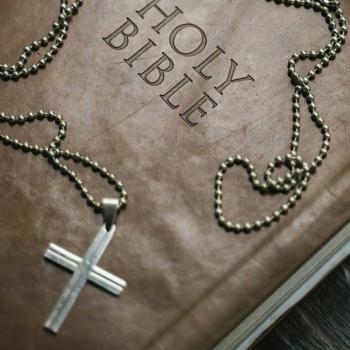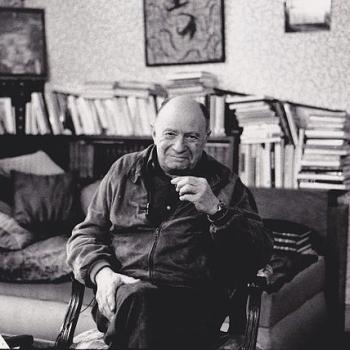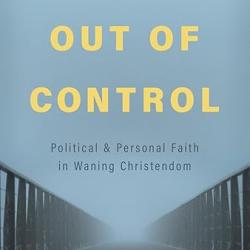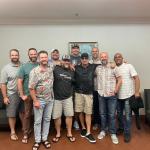A New Research Project: Editing/Revising the Handbook of Denominations in the United States
Many years ago I began collecting and reading editions of Abingdon Press’s Handbook of Denominations in the United States edited then by Frank S. Mead. I think the first edition I perused, probably in my father’s library, was the 1965 New Fourth Edition. Since then Abingdon has published eight new editions edited in succession by Mead, Samuel Hill, and Craig Atwood. The most recent edition is the thirteenth (2010).
As a young teen I was fascinated by denominations—probably as much or more than any person my age. There was no internet then, so my sources of information were books and people. Mead’s Handbook became a major reference work for me, as it has been for many people.
It’s hard to say, this much later, what sparked my curiosity about, almost obsession with, denominations. Looking back to then I can identify a few possibilities. My large, extended family (I had sixty-five first cousins!) consisted of uncles and aunts who were passionate about their denominational identities. Family reunions often included discussions of their similarities and differences and I listened. Afterwards, on the way home, I often asked my father, a Pentecostal minister, about those relatives’ denominations. Among them were: Presbyterian, Christian Reformed, Methodist, Church of God (Anderson, Indiana), Evangelical Free, Evangelical Covenant, Roman Catholic, United Pentecostal, and Open Bible (ours). One of my father’s brothers belonged to a movement my father called “Two By Twos.” Sociologists of religion call them “The Church with No Name.” My uncle called it “The Truth.” That sparked my curiosity—especially when I learned that my uncle and his family would not discuss their denomination (they didn’t call it that) with anyone in the family.
Our little Pentecostal group—Open Bible Standard Churches, Inc. (now Open Bible Churches)—also claimed not to be a denomination. As I was growing up in it I often heard my uncle who was its president say it was a “movement” or “fellowship” and not a denomination. My Church of God relatives also claimed theirs wasn’t a denomination. (Some of them claimed all true Christians belonged to their “movement”—including us—which certainly sparked my curiosity as we never attended it!) And yet, both our “movement” and the Church of God were listed and described in the Handbook as “denominations.” That piqued my curiosity.
Somehow out of that messy religious family milieu I developed an intense interest in denominations. I eagerly looked forward to each new edition of the Handbook of Denominations. I began collecting them and have owned many editions since that first 1965 one. As I gained access to the internet and the world wide web in the 1980s and 1990s, and perused other reference books about denominations (e.g., J. Gordon Melton’s many books about American religion including his massive Encyclopedia of American Religion) I began to wonder about the organization and contents of the Handbook. I believed I saw some flaws in the book. After the tenth edition appeared in 1995 I sent the publisher a letter pointing out some of the flaws. Soon after that the Abingdon editor over reference books met with me at a meeting of the American Academy of Religion. I presented him with a detailed list of what I thought were problems in the book and suggestions for fixing them (e.g., deleting some defunct denominations, creating new categories, moving denominations to other categories, including some overlooked denominations, etc.)
That Abingdon editor asked if I would be interested in becoming the Handbook’s new editor as Samuel Hill was retiring from that role. I declined because I had just become editor of Christian Scholar’s Review and had several book ideas to pursue. Imagine my surprise to see almost all of my very specific suggestions incorporated into the eleventh edition in 2001. That new edition was extensively revised and reorganized—pretty much along the lines I had laid out in writing for the Abingdon editor. The new Handbook editor, Craig Atwood, welcomed my further suggestions and mentioned me in the introductions to the twelfth and thirteenth editions. I became a kind of unofficial consultant—feeding Atwood news of new denominations and changes in existing denominations for his consideration. He often followed my suggestions.
I don’t remember when, but sometime after either the twelfth or thirteenth edition Christian Century magazine asked me to review the Handbook which I did and my review was published. (I don’t keep copies or records of all my book reviews; I wrote too many over the years.) My review was mostly positive, but I pointed out innovations I did not particularly like such as the inclusion of a number of “megachurches” in the contents. (In my opinion a megachurch is not a denomination unless it evolves into one with several, even many, congregations spinning off from it.)
Recently, sometime this year (2015), I contacted Abingdon Press asking when the fourteenth edition of the Handbook would be published. The usual pattern has been a new edition about every four to five years. The publisher informed me that they had no plans to publish a new edition; they were going to let the Handbook die. I was dismayed; I think the Handbook is an important reference work not replaced by internet-based alternatives (of which there are many). I’ve perused those and, in my opinion, most of them, if not all of them, are amateurish and not reliable.
Then I received an invitation from an Abingdon editor asking if I would like to edit a fourteenth edition of the Handbook of Denominations in the U.S. We then talked on the phone for a long time and he agreed to all my conditions and even suggestions. With certain limitations in place, of course, I am quite free to revise it “my way” and that I plan to do. The fourteenth edition, hopefully to be published in a couple years, will have significant changes.
I just signed the contract with Abingdon (the United Methodist Publishing House), who published my recent book Counterfeit Christianity (2015), to edit/revise the Handbook for its fourteenth edition.
I am fully aware of how weird this will sound to people with no strong interest in denominations, but I must say this is a kind of dream come true. How little could I have guessed when I was thirteen or fourteen years old and began perusing and then collecting Handbook editions that someday I would be its general editor! The fourteenth edition, like those before it, for reasons I don’t fully understand, will still show on its cover Frank S. Mead and Samuel Hill as editors. Mead is long deceased. I have not been able to determine if Samuel S. Hill is still alive. If so, he is long retired. My name will follow theirs—as editors of the Handbook even though they are no longer involved with it.
So this signals a definite turning point in my career as a theologian—toward the scholarly study of American religion in general, focusing especially on Christian diversity. I will still teach courses in theology and ethics and continue to write about them. However, for at least the next two year, if not indefinitely, I will focus more on American Christian denominations. One thing I plan to do with the Handbook is incorporate more information into the entries about denominations’ distinctive beliefs and practices.
I hope you, my faithful readers, and others who may “come on board” for this purpose, will help me with this project. Many of you have already suggested new denominations for consideration for inclusion in the Handbook. I have a long list of those to investigate. With the proliferation of new denominations in this allegedly “postdenominational” age, some criteria must be developed for deciding which deserve inclusion and which do not. (My colleague J. Gordon Melton catalogued about twelve hundred distinct religious sects in America! Obviously the Handbook, in order to useful, will have to, as always, be somewhat selective.)
With the publisher’s permission, I hope to post here (in the future) the thirteenth edition’s table of contents, together with my list of new denominations for possible inclusion in the fourteenth edition, and ask you “out there” to mention denominations (by whatever label) you think deserve inclusion in the fourteenth edition.
A major change in the fourteenth edition—from every previous edition—will be limitation to Christian-rooted denominations (not using any criteria of “orthodoxy”). All previous editions have been inconsistent in attempting to include non-Christian religious groups. With the influx of immigrants and religious emissaries and their establishments of non-Christian religious movements and sects from especially Asia and Africa, it is becoming impossible fairly to include non-Christian groups together with Christian ones in a single volume. I hope either Abingdon or someone else will publish a reference handbook about world religions in the United States.












